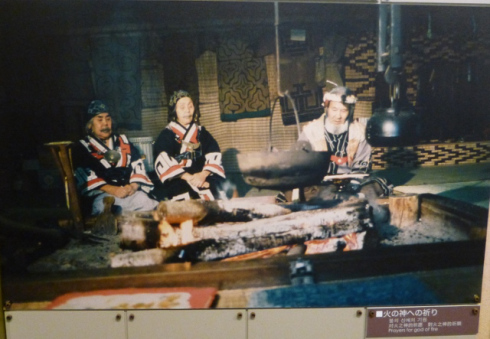
Ainu prayer ritual to the god of fire (this and other photos courtesy Sato)
Though they are few in number now, the Ainu of Hokkaido have great appeal to some because of their ancient traditions. Ethnologists believe they are the remnant of Japan’s original Jomon people, and their spiritual heritage reaches far back into the realm of prehistory. For Joseph Campbell they offered a compelling picture of how religion evolved in its earliest form.
The following informative piece is taken from the blog ‘Discover Japan’ by Yumiko Sato, writer and music therapist living in Aomori. Her writing is hosted on Huffington Post UK, and the link carries a listing of her articles. I’m very grateful to Yumiko for her permission and cooperation. (All photos on this page are taken from her blog.)
**************************************************
Yumiko writes….
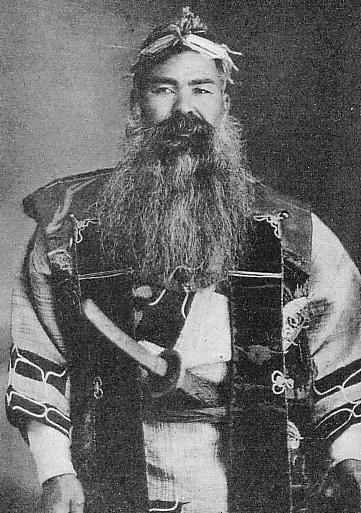
An Ainu elder, around 1930
After visiting the Ainu Museum in Shiraoi, Hokkaido, I wrote two posts about the Ainu, indigenous people of Japan who still live throughout the country. (See here and here.) There are about 23,000 – 24,000 Ainu in Hokkaido today, but this doesn’t include those living outside Hokkaido. The exact number of the Ainu living in Japan is unknown. One reason for this is that some feel the need to hide their identities in order to avoid discrimination.
I decided to look deeper at the Ainu culture, because I knew so little about it. It seemed strange that the indigenous people of Japan had mostly been ignored by its own country. I don’t know anyone personally who discriminates against the Ainu. At the same time I don’t know anyone who is interested in their culture either. This indifference is perhaps the source of discrimination. My hope is that sharing the information will help you learn about their unique culture and traditions.
One can not understand the Ainu without learning about their spirituality, since it’s central to their lives. Their spiritual practices are rich and complex. They’re different from Shinto, the traditional Japanese religion, and they don’t fit the usual definition of animism.
The Ainu felt the presence of the spirits of the dead in their day to day lives. They believed that the human lives were protected by the dead spirits who lived in all things that existed in the human world. At the museum the first thing on display was a large board depicting different gods – solar deity, god who rules the fish, god who rules the deer, god who rules the earth, god of fire, and so on.
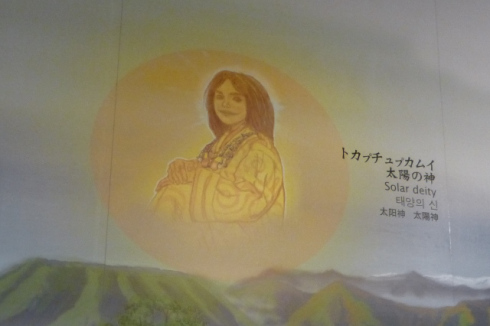
The Ainu solar deity
“Ainu” means “human” as opposed to “kamuy” (gods). The Ainu believed that Gods existed everywhere in the world. This included not only natural phenomenons but also the man made objects, such as the lacquerware boxes which were used for important rituals. The lacquerware boxes were also symbols of power and wealth, since the Ainu gained them through trade with the ethnic Japanese.
To acquire one lacquerware box the Ainu had to offer a number of valuable items, such as a hundred of salmons or furs of several bears. So the house with many lacquerware suggested that the man of the house was a good hunter, and that the family didn’t have to struggle with foods.
Inaw [or inau], prayer sticks made of wood, were also very important spiritual icons. There were many different kinds of inaw. Some were offered as gifts to gods or used to communicate with gods, while others were considered gods themselves.
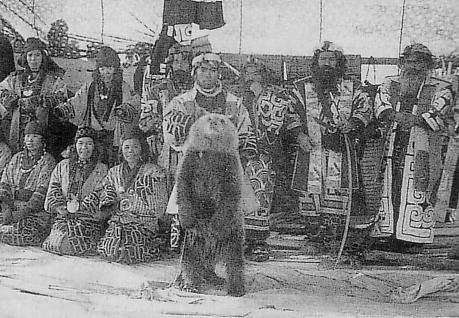
Iyomante spirit-sending ceremony, one of the most important for Ainu
The life of the Ainu was guided by their deep sense of spirituality. On every occasion prayers were offered and various ceremonies were held. “Iyomante” is one of the most important Ainu ceremonies and perhaps the most misunderstood one – the spirit-sending ceremony.
Iyomonte is a ceremony to send back the spirits of bear cubs to the divine world, an intricate ceremony involving many steps and extensive preparations. Iyomante represents the essence of their spiritual life, but its complex nature has also caused outsiders to misunderstand the spiritual traditions of the Ainu.
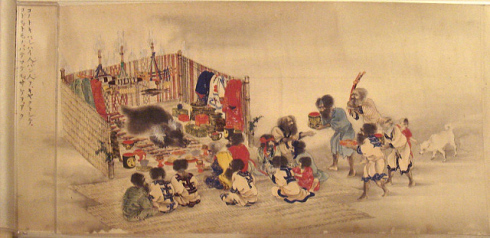
Picture depicting Ainu and bear cub during iyomante
The Ainu people believed that gods took on the forms of animals and visited the human world. The bear god was highly regarded, since it provided many things to humans, such as fur and meat. During iyomante the soul of bear cubs was sent back with abundant offerings, such as foods, sake, treasures, or ornamental arrows.
But what does it mean by sending a bear cub to the divine world?
Iyomante took place between January and February when the snow was deep on the ground. The bear cub, captured in a hibernation den during winter, had been kept in a cell next to the house. The Ainu people often raised the bear as a part of the family and developed a deep bond.
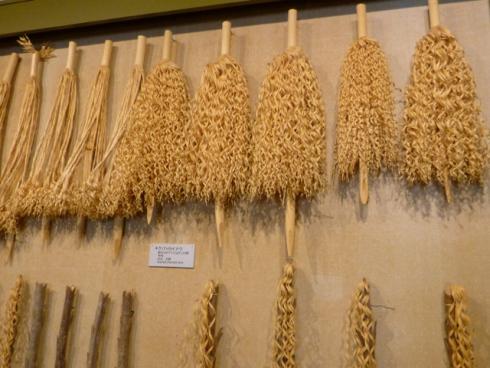
Inaw, the ritual wood shaving sticks used in prayers.
It took nearly a month to prepare for iyomante. Two weeks prior to the ceremony they began making sake and dango (dumplings). A few days before they started making inaw, important spiritual icons of the Ainu. On the day before the ceremony they offered a prayer to the fire goddess. This was done prior to all ceremonies because communication with other kamuy (deities and spirits) was impossible without her divine intervention.
After the prayer people celebrated with dance, song, and story telling, which sometimes lasted until the midnight. Next day iyomante took place. It began by offering prayers to the god of fire once again, which followed by placing inaw in certain ways to make an altar like structure.
After lunch they took the bear out of the cell and tied him/her to a post with a rope. The bear cub would play while people offered a prayer. Women would line up in front of the house, clapping and dancing “rimuse,” the last dance to show God that this was in the form of animals called “bear” on this earth.
Eventually men would shoot arrows and kill the bear. Then the prayers were offered again to the bear. Some men would place dango (dumplings) and kurumi (walnuts) next to the body while others drop dango from the roof of the house. It was believed that the bear would take those things to the divine world. Once the dango was scattered, a young man would shoot an arrow into the sky toward the East, a sacred direction to the Ainu.
Even though the bear was ceremonially killed, he was not a sacrifice to god. Instead the Ainu believed that a god spirit came to the people, disguised as a bear, and that the death of the bear released the spirit, allowing it to return to god’s land.
***************************************************
For the current situation regarding Ainu, including their position as an official minority and a politician’s assertion that they no longer exist, please see this article. For a seven-minute documentary, see this youtube video.
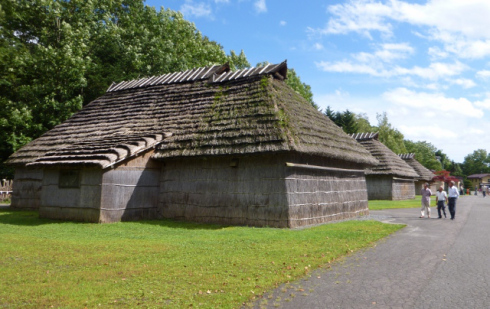
Traditional housing in Hokkaido at the Ainu museum
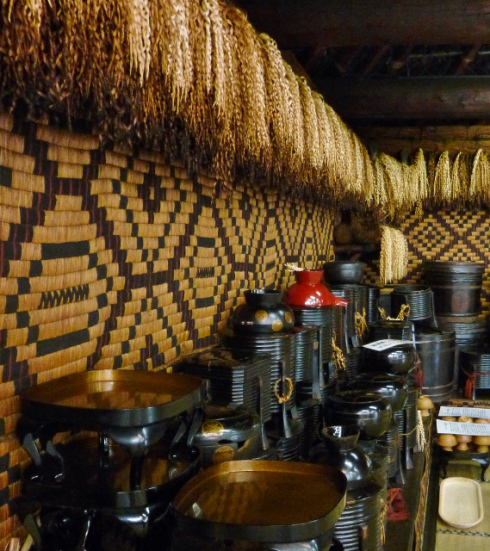
Ainu house interior decoration with inaw, Some were used multiple times, and some disposed of after being used for a single prayer.

My husband and I have been interested in Indigenous cultures for many years, especially how we can learn from their traditional knowledge. We have been keen to discover more about Ainu, particularly as they visited northern Tasmania a few years ago to meet the local Aboriginal people. The connection to where we live, and other similarities between Tasmania and Hokkaido, made visiting the Ainu Museum in Shiraoi a priority. Recently we had the opportunity to fulfil our wish. The Museum was very informative and had excellent descriptions in english in the main museum. We particularly liked the mural showing the different Ainu activities and gods. Yumiko’s article provides an excellent description of Ainu spirituality and Iyomante. Even knowing this, one thing that we found difficult to reconcile at the Museum on our visit in May was the very small metal cages that four Hokkaido bears were kept in. To us it seemed like the bears had gone ‘stir crazy’ as some animals kept in small spaces are prone to do. As ‘outsiders’ who only speak english, we weren’t able to find anyone to ask about the bears. There is no doubt more to it than meets the eye. We’d be very happy to learn more about the current treatment of the bears and clear up any misunderstandings that we might have.
Thanks for the input, Jann. I am going to take up the matter of the bears as it’s unacceptable on any level for bears to be mistreated in that way. Doing it for spiritual purposes makes it even worse in my opinion. Why human beings feel they can treat animals so cruelly, whether in zoos, factory farming, laboratory testing or hunting for pleasure, is utterly beyond me.